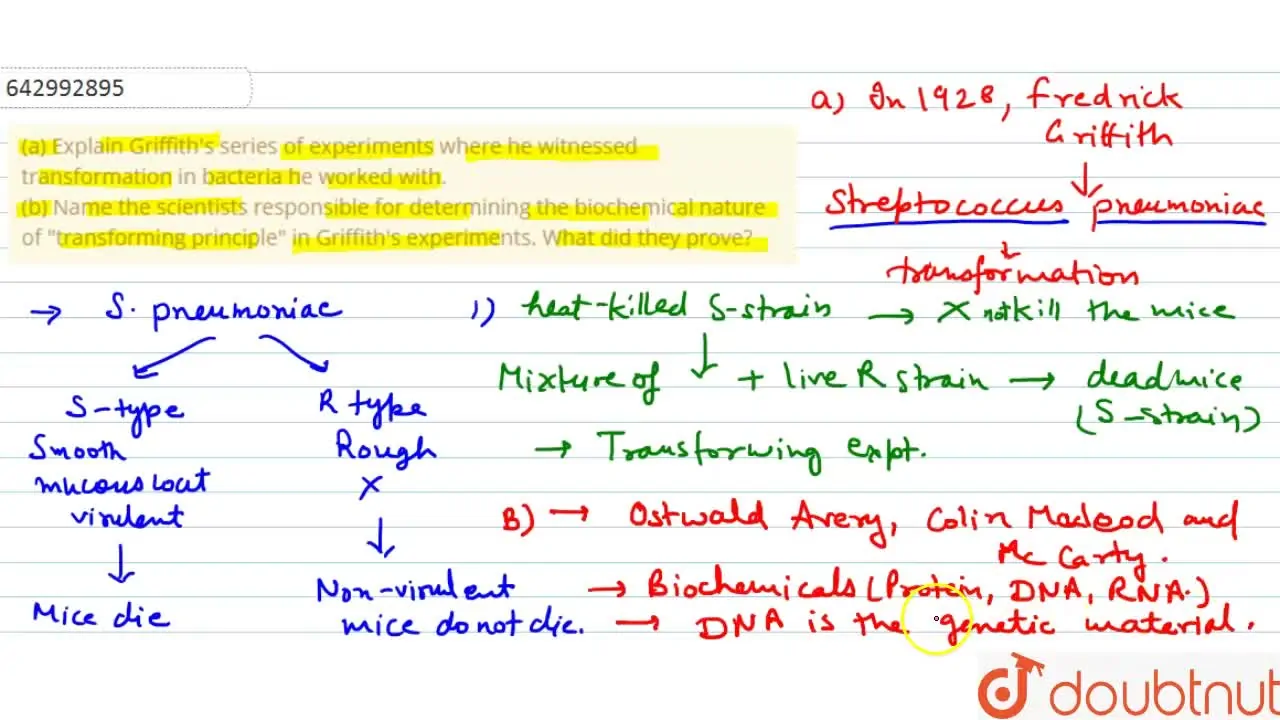(a) Explain Griffith's series of experiments where he witnessed transformation in bacteria he worked with.
(b) Name the scientists responsible for determining the biochemical nature of "transforming principle" in Griffith's experiments. What did they prove?
(a) Transformation was first studied by a British doctor, S.F. Griffith in 1928. He was studying pathogenicity of different strains of bacterium Streptococcus pneumoniae, also known as Diplococcus or Pneumococcus pneumoniae. The bacterium has two strains virulent and nonvirulent. The virulent strain causes pneumonia. Its bacteria are known as S-type because when grown on suitable medium they form smooth colonies. These diplococci are covered by a sheath of mucilage (polysaccharide) around them. The sheath is not only the cause of toxigenicity but also protects the bacteria from phagocytes of the host. The nonvirulent type of bacteria do not produce the disease. They form irregular or rough colonies. These diplococci are devoid of mucilage sheath. The nonvirulent bacteria are, therefore, called rough or R-type. Griffith tested the virulence of the two strains of Pneumococcus by injecting the live R II-type and live S III-type bacteria separately into mice. He found that the R-type bacteria did not produce any disease while the S-type bacteria caused pneumonia and then death in the mice. However, heat killed (at 82∘C−90∘C) S-type bacteria did not produce any symptom of the disease. Finally Griffith injeced a combination of live R-type and heat killed S-type bacteria into mice. None of these bacteria are harmful when present alone. When injected with the mixture of the two some mice survived while others developed the disease of pneumonia and died. Autopsy of the dead mice showed that they possessed both the types of bacteria (virulent S-type and nonvirulent R-type) in living state though the mice had been injected with dead virulent and living nonvirulent bacteria. The occurrence of living S-type virulent bacteria is possible only by their formation from R-type non virulent bacteria which pick up the trait of virulence from dead bacteria. The phenomenon is called Griffith effect or transformation. Griffith proposed that the transforming principle is a chemical substance released by heat killed bacteria. It changed the R-bacteria into S-bacteria It was a permanent genetic change as the new S-type bacteria formed only S-type progeny However, the work of Griffith could not prove (a) Whether or not mice were essential for transformation by providing some important chemical. The character of virulence could belong to any component of S-type bacteria polysaccharide of mucilage, protein or DNA Soon it was found that mice were not required for transformation as the culture medium containing dead S-type bacteria could induce the character of virulence in the nonvirulent bacteria.
(b) Avery. MacLeod and McCarty purified biochemicals from the heat killed S-type bacteria into three components-DNA, carbohydrate and protein DNA fraction was further divided into two parts: one with deoxyribonuclease or DNase and the other without it. The four components were then added to separate culture tubes containing R-type bacteria. The culture tubes were allowed to remain undisturbed for some time. They were then analysed for bacterial population
R-type + Protein S-type R-type
R-type + Carbohydyrate S-type R-type
R-type + (DNA of S - type + DNase ) R-type
R-type + DNA of S - type R-type + S-type
Only DNA of Style can change R-type of bacteria into S-type. Therefore, the character or gene of virulence is located in DNA Genes of other characters would similarly be located in this chemical Thus they proved that the chemical to be inherited is DNA and it forms the chemical or molecula basis of heredity.
Related Playlists
- BOOK - TRUEMEN BIOLOGY ENGLISHCHAPTER - GENETICS AND EVOLUTION EXERCISE - SECTION-C45videos
GENETICS AND EVOLUTION
- BOOK - TRUEMEN BIOLOGY ENGLISHCHAPTER - GeneticsEXERCISE - ASSERTION AND REASON122videos
Genetics
- BOOK - TRUEMEN BIOLOGY ENGLISHCHAPTER - HUMAN HEALTH AND DISEASEEXERCISE - MULTIPLE CHOICE QUESTIONS209videos
HUMAN HEALTH AND DISEASE
Similar Questions
(a) Explain Griffith’s series of exeeriments where he witnessed transformatio in bacteria he worked with.
(b) Name the scientists responsible for determining the biochemical nature I “transforming principle” in Griffith’s experiments. What did they prove ?View SolutionWhat is the basic concept of transformation experiment of Griffith:-
View SolutionWhat is the result of transformation experiment of Griffith :-
View Solution(a) Describe the various steps of Griffith's experiment that led to the conclusion of the 'Transforming Principle'.
(b) How did the chemical nature of the 'Transforming Principle' get established?View Solution(a) Describe the various steps of Griffith's experiment that led to the conclusion of the 'Transforming Principle'.
(b) How did the chemical nature of the 'Transforming Principle' get established ?View Solution(a) Describe the various steps of Griffith's experiment that led to the conclusion of the 'Transforming Principle'.
(b) How did the chemical nature of the 'Transforming Principle' get established ?View Solution(a) Describe the various steps of Griffith's experiment that led to the conclusion of the 'Transforming Principle'.
(b) How did the chemical nature of the 'Transforming Principle' get established ?View SolutionThe biochemical nature of transforming principal was defined by-
(a) Griffith
(b) Avery Macleod, McCarty
(c) Watson and Crick
(d) TaylorView SolutionAnswer the following questions based on Meselson and Stahl s experiment: (a) Write the name of the chemical substance used as a source of nitrogen in the experiment by them. (b) Why did the scientists synthesise the light and the heavy DNA molecules In the organism used in the experiment ? (c) How did the scientists make it possible to distinguish the heavy DNA molecule from the light DNA molecule ? Explain. ((1) Write the conclusion the scientists arrived at after completing the experiment.
View SolutionWhat is the inference extracted from Griffith's transformation experiments?
View Solution


